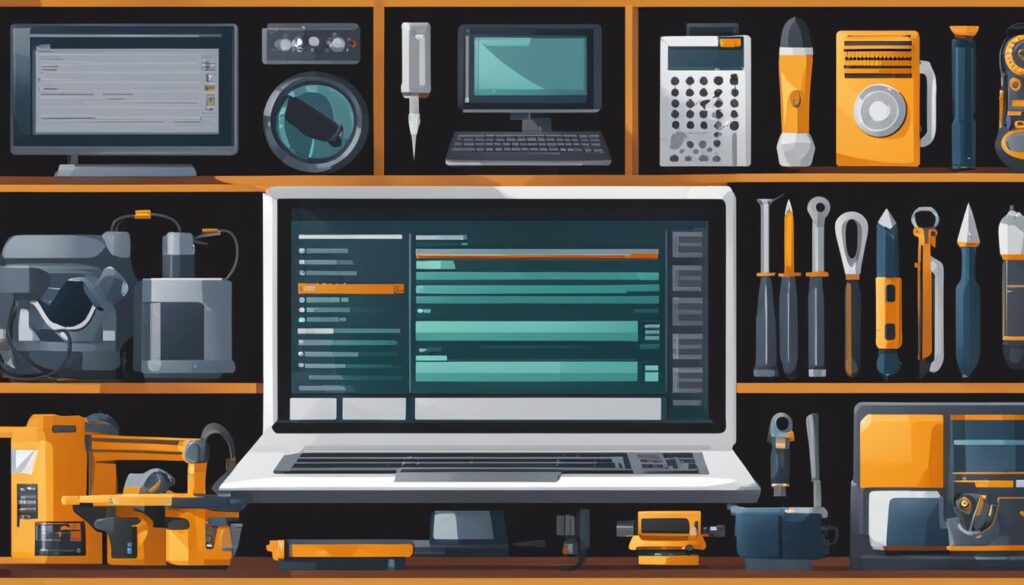Existing customer? Sign in
Expert Software Maintenance Tips for Stability

Did you know that inadequate software maintenance can cost businesses up to 120% of the initial development cost?
Software maintenance is a critical process that ensures the smooth functioning and longevity of software applications. It involves updating and modifying existing software to address bugs, optimize performance, enhance security, and adapt to changing technological trends and market demands.
Whether you are a software maintenance company or a business relying on software, understanding the best practices for software maintenance is crucial to avoid costly disruptions and setbacks. In this article, we will explore expert tips and strategies for effective software maintenance, so you can ensure the stability and performance of your applications.
Key Takeaways:
- Software maintenance is essential for improving reliability, optimizing performance, enhancing security, and adapting to changes in technology and market demands.
- There are four types of software maintenance – corrective, adaptive, perfective, and preventive – each addressing specific goals and challenges.
- Challenges in software maintenance include limited resources, lack of documentation, legacy code, and scope creep.
- Best practices for software maintenance include regular updates and patches, proactive monitoring and testing, documentation and version control, and effective collaboration and communication.
- By following these expert tips, businesses can ensure the stability and longevity of their software applications, maximizing their value and minimizing costs.
What Is Software Maintenance?
Software maintenance is a crucial aspect of the software development lifecycle. It involves the ongoing process of updating and changing existing software to ensure it continues to function correctly and meets the evolving needs of users.
There are several key activities involved in software maintenance:
- Bug fixing: Identifying and resolving software defects to improve functionality and user experience.
- Performance optimization: Enhancing the speed, efficiency, and overall performance of the software.
- Feature enhancements: Adding new features or functionalities to address user requirements and stay competitive in the market.
- Migration: Transitioning the software to new hardware or virtual environments to ensure compatibility and scalability.
- Re-engineering: Restructuring and reworking the software to improve its maintainability, scalability, and overall quality.
- Documentation: Creating and updating documentation to facilitate understanding, maintenance, and future development of the software.
Effective software maintenance is essential for keeping the software competitive and relevant to its target audience. It ensures that the software remains reliable, performs optimally, and meets the changing needs of users.
Software maintenance is like giving your software a check-up to ensure it’s in good health and functioning as expected. It involves fixing bugs, improving performance, adding new features, and maintaining proper documentation.
Benefits of Software Maintenance
Software maintenance offers several benefits:
- Improving reliability: By addressing bugs and errors, software maintenance enhances the reliability and stability of the software.
- Optimizing performance: Performance optimization activities ensure the software operates at its best, with improved speed and efficiency.
- Ensuring security: Regular maintenance helps identify and fix vulnerabilities, improving the overall security of the software.
- Adapting to changing technology trends: Maintaining the software allows it to stay compatible with new technologies and industry trends, ensuring its longevity and relevance.
- Meeting user needs: Feature enhancements and continuous improvement help the software address evolving user requirements, improving user satisfaction and retention.
Software maintenance is an ongoing process that requires regular attention and effort to keep the software in optimal condition.
| Software Maintenance Activities | Benefits |
|---|---|
| Bug fixing | Improved functionality Enhanced user experience |
| Performance optimization | Increased speed and efficiency Better resource utilization |
| Feature enhancements | Meeting user requirements Competitive advantage |
| Migration | Compatibility with new hardware Scalability |
| Re-engineering | Maintainability and scalability Code quality improvement |
| Documentation | Improved maintainability Knowledge transfer |
By investing in thorough software maintenance, businesses can ensure that their software remains reliable, secure, and aligned with the needs and expectations of their users.
Why Does Software Maintenance Matter?
Software maintenance is a vital process that plays a crucial role in the overall success and longevity of software applications. Beyond the initial development phase, ongoing maintenance is essential to ensure the software’s reliability, stability, and performance. By addressing bugs and errors, optimizing performance speed and efficiency, and enhancing security measures, software maintenance helps businesses achieve a more robust and secure computing environment.
One of the significant benefits of software maintenance is the reduction of downtime and disruption. By proactively identifying and addressing issues that can cause interruptions in business operations, software maintenance minimizes the impact of unexpected software failures. This proactive approach helps businesses avoid costly downtime and consequent disruptions to their processes, ensuring smooth and uninterrupted operations.
Another critical aspect of software maintenance is its ability to adapt the software to changing technology trends and market demands. As technology continues to evolve at a rapid pace, software must keep pace with the latest advancements to remain relevant and competitive. Through regular maintenance, software can be updated to stay compatible with new hardware and software, incorporating new features and functionalities that cater to evolving user needs.
Improving Reliability and Stability
Software maintenance plays a pivotal role in improving the overall reliability and stability of the software. By addressing bugs, errors, and any other issues, maintenance activities instill a higher level of trust and confidence in the software’s performance. Regular updates ensure that the software operates smoothly, minimizing the risk of system failures and providing a stable foundation for users to rely on.
Optimizing Performance
Efficient performance is vital for any software application, and software maintenance plays a crucial role in optimizing performance speed and efficiency. By continually monitoring and fine-tuning the software, maintenance activities help identify and address performance bottlenecks, ensuring that the software operates at its peak performance level. This optimization enhances user experience and productivity, enabling businesses to get the most out of their software investment.
Improving Security
Software maintenance is instrumental in maintaining a robust and secure computing environment. By regularly updating and patching the software, maintenance activities help guard against vulnerabilities and potential security breaches. By addressing security concerns promptly, software maintenance ensures that sensitive data and business operations remain protected, mitigating the risk of cyber threats and unauthorized access.
Reducing Downtime and Disruption
Through proactive maintenance, software can identify and address issues before they escalate into significant problems. By mitigating potential risks, software maintenance minimizes the occurrence of unexpected system failures, thereby reducing downtime and avoiding disruptions to business operations. This proactive approach allows businesses to maintain a smooth workflow and ensures uninterrupted productivity.
Adapting to Changing Technology Trends
The field of technology is constantly evolving, and software needs to adapt to these changes to remain effective and relevant. Software maintenance facilitates this adaptation by keeping the software compatible with new hardware and software, incorporating the latest advancements, and embracing emerging technology trends. By staying up-to-date, software can leverage new capabilities, satisfy evolving user expectations, and remain competitive in the market.
Adapting to Market Demands
Market demands are ever-changing, and software must be flexible and adaptable to meet these evolving needs. Software maintenance helps businesses stay ahead of the curve by adding new features and functionalities to the software. By continually improving and expanding its capabilities, software maintenance ensures that businesses can address emerging market demands and better serve their customers.
Types of Software Maintenance
Software maintenance involves different types of activities aimed at ensuring the proper functioning and improvement of software applications. These activities include:
- Corrective Maintenance: This type of maintenance focuses on fixing errors and issues discovered in the software. It involves identifying and addressing bugs, vulnerabilities, and other problems that affect the system’s stability and performance.
- Adaptive Maintenance: Adaptive maintenance involves making changes to the software to adapt it to new environments, technologies, or requirements. It ensures that the software continues to operate seamlessly even as its surroundings evolve.
- Perfective Maintenance: Perfective maintenance aims to enhance the system’s operations and performance. It focuses on improving the software’s efficiency, scalability, and user experience. This type of maintenance often involves performance optimization, code refactoring, and adding new features to meet evolving user needs.
- Preventive Maintenance: Preventive maintenance aims to proactively identify and mitigate potential vulnerabilities and issues before they impact users. It involves analyzing the software, monitoring its performance, and implementing measures to prevent potential problems from occurring.
In summary, the different types of software maintenance—corrective, adaptive, perfective, and preventive—play vital roles in ensuring the stability, efficiency, and security of software applications. By addressing errors, adapting to changes, enhancing performance, and proactively mitigating issues, software maintenance helps keep systems running smoothly and meeting user expectations.
| Type of Maintenance | Description |
|---|---|
| Corrective Maintenance | Focuses on fixing errors and issues discovered in the software. |
| Adaptive Maintenance | Involves making changes to the software to adapt it to new environments, technologies, or requirements. |
| Perfective Maintenance | Aims to enhance the system’s operations and performance, focusing on improving efficiency, scalability, and user experience. |
| Preventive Maintenance | Proactively identifies and mitigates potential vulnerabilities and issues before they impact users. |
Understanding the different types of software maintenance allows organizations to effectively manage and prioritize their maintenance efforts, ensuring that their software stays reliable, efficient, and up-to-date.
Conclusion
Software maintenance is a critical process that ensures the stability and performance of software applications. By following the best practices, businesses can overcome various challenges that arise during maintenance and maximize the value and longevity of their software.
One of the main challenges in software maintenance is the limited resources, which can hinder the timely resolution of issues and the implementation of necessary updates. Additionally, the lack of proper documentation creates difficulties in understanding the software’s intricacies and can lead to errors during maintenance.
Legacy code is another challenge that software maintenance teams often face. It refers to outdated or obsolete programming code that is still operational in the software. This code can be challenging to modify or enhance, leading to compatibility issues with new technologies and making maintenance more complex.
Furthermore, scope creep, or the continuous expansion of project requirements, can pose significant challenges in software maintenance. This occurs when new features or functionality are added to the software without proper planning, often resulting in increased complexity and a higher risk of errors.
To address these challenges, it is crucial to follow best practices. Regular updates and patches should be implemented to ensure that the software is up to date and free from vulnerabilities. Proactive monitoring and testing help identify potential issues before they impact users, ensuring continuous performance and stability.
Documentation and version control play a crucial role in software maintenance as they provide a clear understanding of the software’s structure, functionality, and changes made during maintenance. Collaboration and communication among team members and stakeholders foster a more efficient and effective maintenance process.
By adhering to these best practices, businesses can overcome the challenges in software maintenance and ensure that their software remains stable, reliable, and adaptable to evolving needs and technologies.
FAQ
What is software maintenance?
Software maintenance is the process of updating and changing existing software to ensure it continues to function correctly and meet the evolving needs of users. This includes bug fixing, performance optimization, feature enhancements, migration, re-engineering, and documentation.
Why is software maintenance important?
Software maintenance is important for improving reliability, optimizing performance, enhancing security, reducing downtime, and adapting to changing technology trends. It helps keep the software competitive and relevant to its target audience.
What are the types of software maintenance?
The four types of software maintenance are corrective maintenance, adaptive maintenance, perfective maintenance, and preventive maintenance.
What are software maintenance best practices?
Software maintenance best practices include regular updates and patches, proactive monitoring and testing, documentation and version control, and collaboration and communication.
What are the challenges in software maintenance?
Challenges in software maintenance include limited resources, lack of documentation, legacy code, and scope creep.
Source Links
- https://cleancommit.io/blog/importance-of-software-maintenance-in-software-engineering/
- https://forbytes.com/blog/software-maintenance/
- https://www.infopulse.com/blog/proactive-software-maintenance




